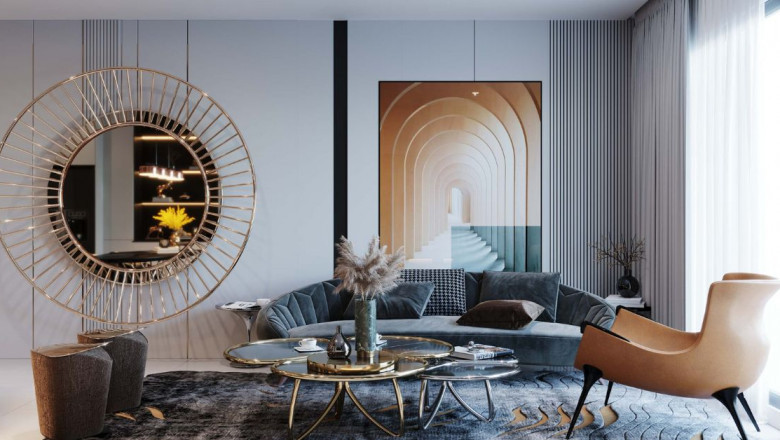views
How to Use Mirrors to Enhance Your Interior Design
Mirrors are one of the most versatile and powerful tools in interior design. When used correctly, they can transform a space by making it appear larger, brighter, and more stylish. Whether you're working with a small apartment or a spacious villa, strategically placing mirrors can enhance your home’s aesthetics and functionality. In this article, we’ll explore how to use mirrors effectively to elevate your interior design with insights from professional Interior Designers.
1. Create an Illusion of Space
One of the most common uses of mirrors in interior design is to create the illusion of a larger space. This is particularly useful in small rooms or narrow hallways where every inch matters. Placing a large mirror on a wall opposite a window or a doorway instantly makes the room feel more open and airy. Best interior designers in Chennai recommend using floor-to-ceiling mirrors or mirrored walls in compact areas to maximize space perception.
2. Enhance Natural Light
Mirrors are excellent for reflecting natural light, which makes a room feel brighter and more welcoming. If your space lacks sufficient windows, strategically placing mirrors near light sources can help bounce light around the room. For instance, positioning a mirror opposite a window allows sunlight to fill the room more evenly. This not only improves illumination but also enhances the overall ambiance of your home.
3. Create a Focal Point
A mirror can act as a stunning focal point in any room. Decorative mirrors with unique frames or shapes can serve as statement pieces that draw attention and add character to a space. Whether it’s an ornate vintage mirror above a fireplace, a sunburst mirror in a hallway, or a modern geometric mirror in the dining room, these elements add visual interest and sophistication to your home.
4. Amplify Your Décor
Mirrors can enhance your existing interior décor by reflecting beautiful elements within the room. For example, placing a mirror near a stunning chandelier or an elegant piece of artwork doubles the impact of these features. Interior Designers often use mirrored furniture, such as coffee tables, cabinets, or console tables, to introduce a touch of glamour and refinement.
5. Improve Room Symmetry and Balance
Mirrors can help create balance in a room by distributing visual weight evenly. In symmetrical designs, placing identical mirrors on either side of a focal point, such as a fireplace or bed, enhances harmony and cohesion. This technique works well in both traditional and contemporary interiors, adding a sense of order and sophistication.
6. Elevate Entryways and Hallways
Entryways and hallways often feel confined and dark due to their limited natural light and space. Mirrors can transform these areas by making them appear more inviting. A large mirror placed near the entrance creates an open and welcoming atmosphere, while a series of smaller mirrors along a hallway can add depth and visual intrigue.
7. Add Functionality to Dressing Areas
In bedrooms and walk-in closets, mirrors serve both aesthetic and practical purposes. Full-length mirrors are essential for dressing areas, allowing you to check your appearance from head to toe. Mirrored wardrobes or sliding doors can also be a stylish and space-saving addition, combining functionality with elegance.
8. Experiment with Shapes and Styles
Mirrors come in various shapes, styles, and frame designs, offering endless possibilities for creativity. Round mirrors soften a space with their curves, while rectangular or square mirrors provide a structured look. Antique mirrors add a touch of vintage charm, whereas frameless mirrors create a minimalist and contemporary feel. Choosing the right mirror style can complement your overall design theme and enhance your interior aesthetics.
9. Layer Mirrors for a Unique Effect
Layering mirrors can create a dramatic and artistic effect in your home. Instead of using a single mirror, consider overlapping multiple mirrors of different sizes and shapes on a feature wall. This adds depth and dimension, giving your space a dynamic and customized look. Many Interior Designers use this technique in modern and eclectic interiors to introduce an element of surprise and creativity.
10. Use Mirrors to Define Spaces
In open-concept homes, mirrors can be used to define different functional areas without blocking light or space. A large mirror behind a dining area can subtly distinguish it from the living room while maintaining an open and airy feel. Similarly, in studio apartments, mirrored partitions can create a sense of separation without making the space feel closed off.
Final Thoughts
Mirrors are a powerful design element that can transform any space when used effectively. From enhancing light and space to adding style and elegance, they offer endless possibilities in interior design. Whether you want to create a spacious feel, highlight a statement piece, or introduce symmetry, mirrors are an excellent addition to your décor. Professional Interior Designers leverage mirrors to craft visually stunning and functional spaces, making them an essential tool in modern home design.













Comments
0 comment